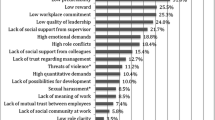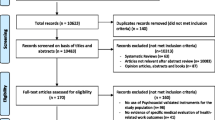Abstract
Objective
To provide an overview of the spectrum of available for measurement and evaluation of work-related psychosocial factors.
Methods
We systematically searched the literature/internet to identify and describe the main available questionnaires and observational instruments for assessment of work-related psychosocial factors (with/without other job stressors).
Results
A total of 33 instruments were identified (26 questionnaires, 7 observational), many (11 questionnaires, 5 observational) linked to national institutions/intiatives. Accessibility of relevant information (on the internet or elsewhere) regarding the instruments varied widely.
Conclusions
This summary of the range of instruments currently available for evaluation of multiple work stressors at individual, group and/or organizational levels may provide a useful tool for operators and researchers.
Similar content being viewed by others
References
Avallone F, Paplomatas A (2005) Salute Organizzativa. Psicologia del benessere nei contesti di lavoro. 1st edn. Raffaello Cortina Editore, Milan
Belkic K (2000) The Occupational Stress Index. An introduction. Job Stress Network [home page on the Internet]. Available from: http://www.workhealth.org/OSI%20Index/OSI%20Introduction.html
Conseil National du Travail (CNT) (2004) La prevention du stress, Convention collective de travail n. 72 [monograph on the internet]. Available from: http://www.cnt-nar.be/DOC-DIVERS/Stress/Prévention%20du%20stress-2004.PDF
Cooper CL, Sloan SJ, Williams JS (1988) Occupational stress indicator management guide. NFER-Nelson, Windsor
Cox T, Mackay CJ (1981) A transactional approach to occupational stress. In: Corlett EN, Richardson J (eds) Stress, work design and productivity. Wiley, Chichester
Cox T, Rial-González E (2005) Work-related stress: the European picture. Work-related stress is a strong negative emotional reaction to work. In: Working on stress Magazines 5 [serial on the internet]. Available from: http://osha.europa.eu/publications/magazine/5
D’Hertefelt H (2002) Measuring psychosocial workload in Belgium. TUTB Newsl (19–20):39–44
De Keyser V, Hansez I (1996) Vers une perspective transactionnelle du stress au travail: pistes d’évaluations méthodologiques. Cahiers de Médecine du Travail 33(3):133–144
Delaunois M, Malchaire J, Piette A (2002) Classification des méthodes d’évaluation du stress en entreprise. Médecine du Travail & Ergonomie 39(1):13–28
Elo AL, Leppanen A, Jankola A (2003) Validity of single-item measures of stress symptoms. Scand J Work Environ Health 29(6):444–451
Elo AL, Leppanen A, Sillanpaa P (1998) Applicability of survey feedback for an occupational health method in stress management. Occup Med 48(3):181–188
Fédération Générale du Travail de Belgique (FGTB) (2002) Stress agir pour le bien-être au travail [brochure on the internet]. Available from: http://www.fgtb.be/CODE/fr/Documents/2002/stress/c15_10e10Idx.htm
French JRP, Caplan RD, van Harrison R (1982) The mechanisms of job stress and strain. Wiley, New York
Frese M, Zapf D (1988) Methodological issue in the study of work stress: Objective vs. subjective measurement of work stress and the question of longitudinal studies. In: Cooper CL, Payne R (eds) Causes, coping and consequences of stress at work. Wiley, New York, pp 375–411
Hackman JR, Oldham (1975) Development of the job diagnostic survey. J Applied Psychol 60(2):159–170
Hurrell JJ, McLaney MA (1988) Exposure to Job Stress: A new psychometric instrument’. Scand J Work Environ Health 14(1):27–28
Hurrell JJ Jr, Nelson DL, Simmons BL (1998) Measuring job stressors and strains: where we have been, where we are, and where we need to go. J Occup Health Psychol 3(4):368–389
Huys R, De Rick K, Vandenbrande T (2005) Enhancing learning opportunities at work. [mongraph on the internet]. Available from: http://ec.europa.eu/education/policies/2010/studies/enhance05_en.pdf
Ivancevich JM, Napier HA, Wetherbe JC (1983) Stress in the Information Systems Professional. [mongraph on the internet]. Available from: http://delivery.acm.org/10.1145/810000/800620/p57-ivancevich.pdf?key1=800620&key2=9920451711&coll=&dl=ACM&CFID=15151515&CFTOKEN=6184618
Johnson JV, Hall EM, Stewart W, Fredlund P, Theorell T (1991) Combined exposure do adverse work organisation factors and cardiovascular disease: towards a life-course perspective. In: Fechter LD (ed) Proceedings of the 4th International Conference on the combined effects of environmental factors. Johns Hopkins University Press, Baltimore
Karasek RA (1979) Job demands, job decision latitude and mental strain: implications for job redesign. Adm Sci Q 24:285–308
Karasek R, Brisson C, Kawakami N, Houtman I, Bongers P, Amick B (1998) The job content questionnaire (JCQ): an instrument for internationally comparative assessments of psychosocial job characteristics. J Occup Health Psychol 3(4):322–355
Kasl SV (1987) Methodologies in stress and health: past difficulties, present dilemma, future directions. In: Kasl SV, Cooper CL (eds) Stress and health: issues in research methodology. Wiley, New York, pp 307–318
Kasl SV (1998) Measuring job stressors and studying the health impact of the work environment: an epidemiologic commentary. J Occup Health Psychol 3(4):390–401
Kompier M (2005) Assessing the psychosocial work environment—”subjective” versus “objective” measurement [editorial]. Scand J Work Environ Health 31(6):405–408
Kristensen TS (1995) The demand-control-support model: methodological challenges for future research. Stress Med 11:17–26
Kristensen TS, Hannerz H, Høgh A, Borg V (2005) The Copenhagen Psychosocial Questionnaire—a tool for the assessment and improvement of the psychosocial work environment. Scand J Work Environ Health 31(6):438–449
Landsbergis P, Theorell T (2000) Measurement of psychosocial workplace exposure variables. In: Schnall P, Belkic K, Landbergis P, Baker D (eds) The workplace and cardiovascular disease. Publ. Hanley Belfus, Inc. pp 163–171
Lazarus RS, Folkman S (1984) Stress, appraisal and coping. Springer, New York
Leitner K, Resch MG (2005) Do the effects of job stressors on health persist over time? A longitudinal study with observational stressor measures. J Occup Health Psychol 10(1):18–30
Levi L, Sauter SL, Shimomotsu T (1999) Work-related stress—it’s time to act. J Occup Health Psychol 4(4):394–396
Lindstrom K (2002) Nordic method for measuring psychosocial and social factors at work. TUTB Newsl (19–20):48–49
McCormick EJ, Jeanneret PR, Mecham RC (1972) A study of job characteristics and job dimensions as based on the position analysis questionnaire (PAQ). J Appl Psychol 56(4):347–368
Moos RH (1981) Work environment scale manual. Consulting Psychologists Press, Palo Alto
Murphy LR, Schoenborn TF (eds) (1987) Stress management in work settings. [monograph on the internet]. DHHS (NIOSH); Publication No. 87-111. Available from: http://www.cdc.gov/niosh/87-111.html
Organization of Work Team Members (NORA) (2002) The changing organization of work and the safety and health of working people: knowledge gaps an research directions. [monograph on the internet]. Cincinnati: NIOSH. Available from: http://www.cdc.gov/niosh/pdfs/02-116.pdf
Osipow SH (1992) Occupational stress inventory. Psychological Assessment Resources, Odessa
Peter RA, Morvan O, Morvan E, (eds) (2004) European ways to combat psychosocial risks related to work organisation: towards organisational interventions? [monograph on the internet]. TNO Work and Employment/PEROSH. Available from: http://tno-arbeid.adlibsoft.com/adlib/docs/Perosh-2004.pdf
Polanyi M, Tompa E (2004) Rethinking work-health models for the new global economy: a qualitative analysis of emerging dimensions of work. Work 23(1):3–18
PREVENT (2005) [homepage on the internet]. Mesurer le stress au travail (la pratique). 2005. Available from: http://fr.prevent.be/net/net01.nsf/p/75A18BC6C4EFD97AC1256AC00045EADF
Quick JC (1998) Introduction to the measurement of stress at work. J Occup Health Psychol 3(4):291–293
Rick J, Briner RB, Daniels K, Perryman S, Guppy A (2001) A critical review of psychosocial hazard measures, Contract research report 356/2001 [monograph on the internet]. HSE Books. Available from: http://www.hse.gov.uk/RESEARCH/crr_htm/2001/crr01356.htm
Rosenstock L (1997) Work organization research at the National Institute for Occupational Safety and Health. J Occup Health Psychol 2(1):7–10
Schaufeli WB, Kompier M (2001) Managing job stress in the Netherlands. Int J Stress Manage 8:15–34
Setterlind S, Larson G (1995) The stress profile—a psychosocial approach to measuring stress. Stress Med 11(2):85–92
Siegrist J (1990) Chronischer Distress und koronares Risiko: Neue Erkenntnisse und ihre Bedeutung für die Pravention. In: Arnold M, v. Ferber C, Henke K.D (Hrsg.) Ökonomie der Prävention. Bleicher, Gerlingen
Siegrist J, Starke D, Chandola T et al (2004) The measurement of effort–reward imbalance at work: European comparisons. Soc Sci Med 58(8):1483–1499
Sims HP, Szilagyi AD, Keller RT (1976) The measurement of job characteristics. Acad Manage J 19:195–212
Theorell T, Hasselhorn HM (2005) On cross-sectional questionnaire studies of relantionships between psychosocial conditions at work and health—are they reliable? Int Arch Occup Environ Health 78:517–522
Vagg PR, Spielberger CD (1999) The job stress survey: assessing perceived severity and frequency of occurrence of generic sources of stress in the workplace. J Occup Health Psychol 4(3):288–292
Van Veldhoven M, Broersen S (2003) Measurement quality and validity of the “need for recovery scale”. Occup Environ Med 60:3–9
Widerszal-Bazyl M, Cieslak R (2000) Monitoring psychosocial stress at work: development of the Psychosocial Working Conditions Questionnaire. Int J Occup Saf Ergon (Spec):59–70
Wiezer N, Nelemans R (2005) Tripod Sigma: an instrument for pro-active stress management. Occup Health Psychol [serial on the Internet] 2(3):15–17. Available from: http://www.ea-ohp.org/downloads/The_Occupational_Health_Psychologist_Vol_2_Issue_3.pdf
Williams JS, Cooper CL (1998) Measuring occupational stress: development of the pressure management indicator. J Occup Health Psychol 3(4):306–321
Wrighy TA, Cropanzano R (2000) The role of organizational behavior in occupational health psychology: a view as we approach the millennium. J Occup Health Psychol 5(1):5–10
Acknowledgments
We thank Lesley Cooper and Martyn Sandbrook for a personal communication on the background to the SRA and PMI questionnaires. This work was supported in part by a grant from the Italian Workers’ Compensation Authority (INAIL), the National Institute for Prevention and Occupational Safety (ISPESL) and the Government of the Region Emilia-Romagna. Any opinions expressed in this paper are those of the authors.
Author information
Authors and Affiliations
Corresponding author
Rights and permissions
About this article
Cite this article
Tabanelli, M.C., Depolo, M., Cooke, R.M.T. et al. Available instruments for measurement of psychosocial factors in the work environment. Int Arch Occup Environ Health 82, 1–12 (2008). https://doi.org/10.1007/s00420-008-0312-6
Received:
Accepted:
Published:
Issue Date:
DOI: https://doi.org/10.1007/s00420-008-0312-6




